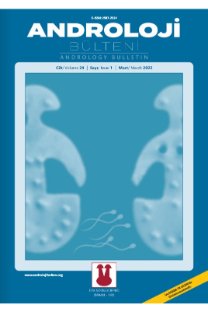Açık radikal retropubik prostatektomi sonrası inflatable penil protez rezervuarı, penoskrotal transvers insizyon ile Retzius alanına güvenle yerleştirilebilir
The inflatable penile prosthesis reservoir can be safely placed in the space of retzius after open radical retropubic prostatectomy through a penoscrotal transverse incision
___
- Mirza M, Griebling TL, Kazer MW. Erectile Dysfunction and urinary incontinence after prostate cancer treatment. Semin Oncol Nurs 2011;27:278–89. [CrossRef]
- Barocas DA, Alvarez J, Resnick MJ, Koyama T, Hoffman KE, Tyson MD, et al. Association Between Radiation Therapy, Surgery, or Observation for Localized Prostate Cancer and Patient-Reported Outcomes After 3 Years. JAMA 2017;317:1126–40. [CrossRef]
- Stolzenburg JU, Graefen M, Kriegel C, Michl U, Morales AM, Pommerville PJ, et al. Effect of surgical approach on erectile function recovery following bilateral nerve-sparing radical prostatectomy: an evaluation utilising data from a randomised, double-blind, double-dummy multicentre trial of tadalafil vs placebo. BJU Int 2015;116:241–51. [CrossRef]
- Kyrdalen AE, Dahl AA, Hernes E, Småstuen MC, Fosså SD. A national study of adverse effects and global quality of life among candidates for curative treatment for prostate cancer. BJU Int 2013;111:221–32. [CrossRef]
- Castiglione F, Ralph DJ, Muneer A. Surgical Techniques for Managing Post-prostatectomy Erectile Dysfunction. Curr Urol Rep 2017;18:90. [CrossRef]
- Salonia A, Burnett AL, Graefen M, Hatzimouratidis K, Montorsi F, Mulhall JP, Stief C. Prevention and management of postprostatectomy sexual dysfunctions. Part 1: choosing the right patient at the right time for the right surgery. Eur Urol 2012;62:261–72. [CrossRef]
- Ciftci H, Verit A, Savas M. Late complications of spontaneous urethral erosion of a malleable penile prosthesis in a young patient. Singapore Med J 2012;53:e120–1.
- Lane BR, Abouassaly R, Angermeier KW, Montague DK. ThreePiece inflatable penile prostheses can be safely implanted after radical prostatectomy through a transverse scrotal incision. Urology 2007;70:539–42. [CrossRef]
- Lledó-García E, Jara-Rascón J, Moncada Iribarren I, PiñeroSánchez J, Aragón-Chamizo 1, Hernández-Fernández C. Penile Prosthesis First and Replacement Surgeries: Analysis of Patient and Partner Satisfaction. J Sex Med 2015;12:1646–53. [CrossRef]
- Dadhich P, Hockenberry M, Kirby EW, Lipshultz L. Penile prosthesis in the management of erectile dysfunction following cancer therapy. Transl Androl Urol 2017;6(Suppl 5): S883–9. [CrossRef]
- Bratu O, Oprea I, Marcu D, Spinu D, Niculae A, Geavlete B, Mischianu D. Erectile dysfunction post-radical prostatectomy - a challenge for both patient and physician. J Med Life 2017;10:13–8.
- Wilson SK, Mulcahy JJ. Penile implants. In: Mulcahy JJ, editor. Male Sexual Function: A Guide to Clinical Management, 2nd ed. New Jersey: Humana Press, Inc.; 2006. pp.331–79.
- Montague DK. Penile prosthesis implantation in the era of medical treatment for erectile dysfunction. Urol Clin North Am 2011;38:217–25. [CrossRef]
- Eid JF. Surgery for erectile dysfunction. In: Wein AJ, Kavoussi LR, Partin AW, Peters CA, editors. Campbell-Walsh Urology, 11th edition. New York: Elsevier; 2016. pp.709–21.
- Turunç T, Deveci S, Güvel S, Peşkircioğlu L. Uluslararası cinsel işlev indeksinin 5 soruluk versiyonunun (IIEF-5) Türkçe geçerlilik çalışmasının değerlendirilmesi. Türk Üroloji Dergisi 2007;33:45–9
- Erdemir F, Bolat MS, Akdeniz E. Penil protezle seks. Androl Bul 2015;17-62:183–6.
- Karpman E, Brant WO, Kansas B, Bella AJ, Jones LA, Eisenhart E, Henry G. Reservoir alternate surgical implantation technique: preliminary outcomes of initial PROPPER study of low profile or spherical reservoir implantation in submuscular location or traditional prevesical space. J Urol 2015;193:239–44. [CrossRef]
- Henry GD, Karpman E, Brant W, Christine B, Kansas BT, Khera M, et al. The Who, How and What of Real-World Penile Implantation in 2015: The PROPPER Registry Baseline Data. J Urol 2016;195:427–33. [CrossRef]
- Lane BR, Abouassaly R, Angermeier KW, Montague DK. Threepiece inflatable penile prostheses can be safely implanted after radical prostatectomy through a transverse scrotal incision. Urology 2007;70:539–42. [CrossRef]
- Hakky T, Lentz A, Sadeghi-Nejad H, Khera M. The Evolution of the Inflatable Penile Prosthesis Reservoir and Surgical Placement. J Sex Med 2015;12 Suppl 7:464–7. [CrossRef]
- Perito P, Wilson S. The History of Nontraditional or Ectopic Placement of Reservoirs in Prosthetic Urology. Sex Med Rev 2016;4:190–3. [CrossRef]
- Levine LA, Hoeh MP. Review of penile prosthetic reservoir: complications and presentation of a modified reservoir placement technique. J Sex Med 2012;9:2759–69. [CrossRef]
- Capoccia EM, Phelps JN, Levine LA. Modified Inflatable Penile Prosthesis Reservoir Placement Into Space of Retzius: Comparing Outcomes in Men With or Without Prior Pelvic Surgery. J Sex Med 2017;14:968–73. [CrossRef]
- Levine LA, Becher E, Bella A, Brant W, Kohler T, MartinezSalamanca JI, et al. Penile Prosthesis Surgery: Current Recommendations From the International Consultation on Sexual Medicine. J Sex Med 2016;13:489–518. [CrossRef]
- Goldstein I, Newman L, Baum N, Brooks M, Chaikin L, Goldberg K, et al. Safety and efficacy outcome of mentor alpha-1 inflatable penile prosthesis implantation for impotence treatment. J Urol 1997;157:833–9
- ISSN: 2587-2524
- Yayın Aralığı: 4
- Başlangıç: 1999
- Yayıncı: Turgay Arık
Fosfodiesteraz Tip-5 inhibitörlerinin semen parametrelerine etkisi
HACI İBRAHİM ÇİMEN, Hacı Can DİREK, FİKRET HALİS, OSMAN KÖSE, AHMET GÖKÇE, HASAN SALİH SAĞLAM
Mustafa Suat BOLAT, Mehmet ÖZEN, Önder ÇINAR, Recep BÜYÜKALPELLİ, RAMAZAN AŞCI
İnfertil bireylerde stres ve stresle başa çıkma yaklaşımları
Rekürren varikosel tanı ve tedavisi
KAAN SÖNMEZ, RAMAZAN KARABULUT, ZAFER TÜRKYILMAZ, Abdullah Can BAŞAKLAR
